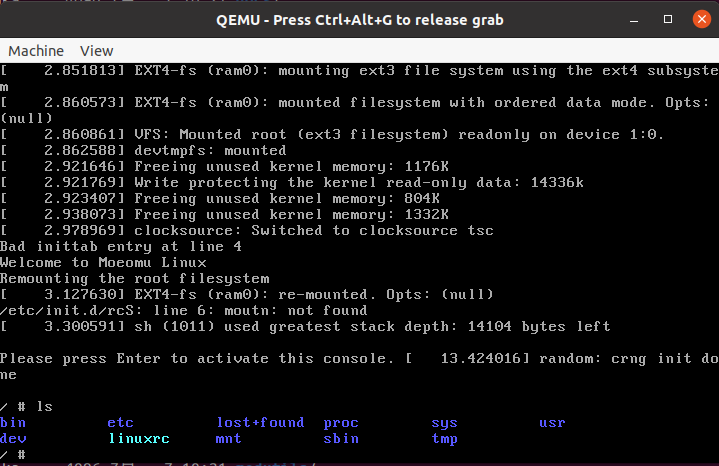Source: Moeomu’s Blog
Prepare the environment
- Ubuntu 20.04 LTS
- Linux 4.9.229
- Busybox 1.33.0
- qemu
Download kernel source code and file system source code
- Download
linux-4.9.229.tar.gzat the site Kernel.org. - Download
busybox-1.33.0.tar.bz2from the site Busybox.net. - Install qemu via apt:
sudo apt install qemu-system-x86.
Compilation
Compiling the kernel
export ARCH=x86。make x86_64_defconfig。make menuconfig。- Check
General Settings -> Initial RAM file system and RAM disk (initramfs/initrd) support. - Check
Device Driver -> Block Devices -> RAM Block Device Support. - Modify
Device Driver -> Block Devices -> RAM Block Device Support -> (65536) default RAM disk size (kbytes).
- Check
If this step reports a
fatal error: curses.h, then installsudo apt install libncurses5-dev.
-
The compiled kernel is placed in the
-
The compiled kernel is placed in the directory
arch/x86/bootunder the file namebzImage.
Compile busybox
- Compile busybox
- Check “Settings -> Build Options -> [*] Build Busybox as a static binary (no fragmented libraries)”.
make && make install。
Packaged file system
-
mkdir etc dev mnt。 -
mkdir -p proc sys tmp。 -
mkdir -p etc/init.d。 -
vim etc/fstab。1 2 3proc /proc proc defaults 0 0 tmpfs /tmp tmpfs defaults 0 0 sysfs /sys sysfs defaults 0 0 -
vim etc/init.d/rcS1 2 3 4 5 6 7 8echo -e "Welcome to Moeomu Linux" /bin/mount -a echo -e "Remounting the root filesystem" mount -o remount rw / mkdir -p /dev/pts moutn -t devpts devpts /dev/pts echo /sbin/mdev > /proc/sys/kernel/hotplug mdev -s -
chmod 755 etc/init.d/rcS -
vim etc/inittab1 2 3 4::sysinit:/etc/init.d/rcS ::respawn:-/bin/sh ::askfirst:-/bin/sh ::cttlaltdel:/bin/umount -a -r -
chmod 755 etc/inittab -
cd dev -
sudo mknod console c 5 1 -
sudo mknod null c 1 3 -
sudo mknod tty1 c 4 1 -
The following code is executed line by line in the busybox source code directory
1 2 3 4 5 6 7 8 9 10#!/bin/bash rm -rf rootfs.ext3 sudo rm -rf fs dd if=/dev/zero of=./rootfs.ext3 bs=1M count=32 mkfs.ext3 rootfs.ext3 mkdir fs sudo mount -o loop rootfs.ext3 ./fs sudo cp -rf ./_install/* ./fs sudo umount ./fs gzip --best -c rootfs.ext3 > rootfs.img.gz -
The final filesystem is generated:
rootfs.img.gz
Running the system with QEMU
-
qemu-system-x86_64 -kernel ./linux-4.9.229/arch/x86_64/boot/bzImage -initrd ./busybox-1.33.1/rootfs.img.gz -append "root=/dev/ram init=/linuxrc" -serial file:output.txt -
Previews are as follows
